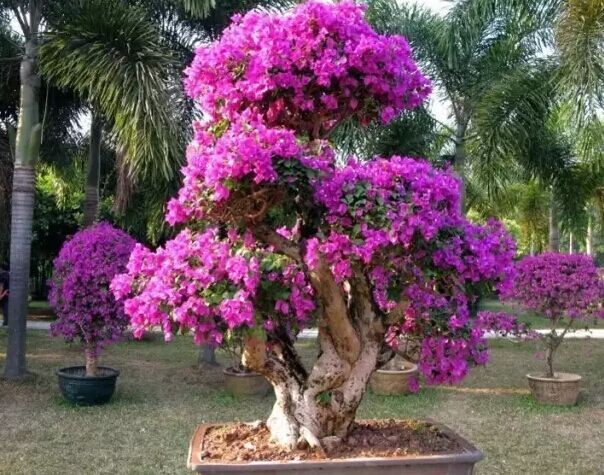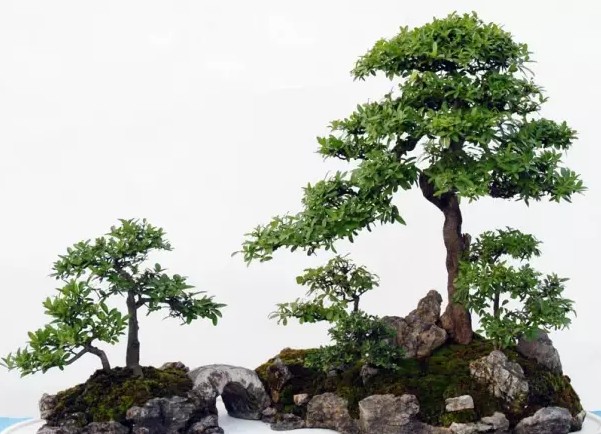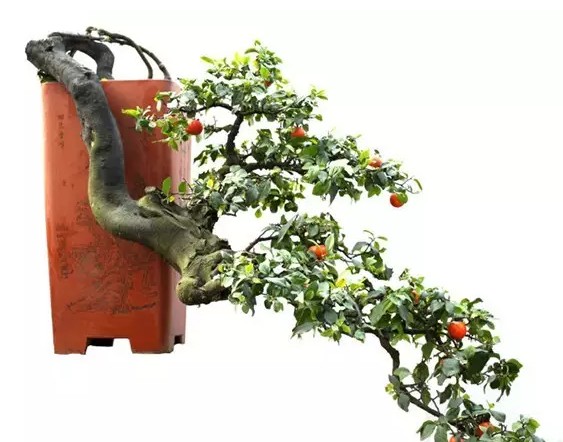How to appreciate the beauty of bonsai
Everyone knows that a good bonsai looks good, but how to enjoy it? Bonsai as a work of art, how to appreciate, is not a simple matter. It requires the viewer to have a certain ideological level, cultural and artistic accomplishment and life experience. As the saying goes, "the layman watches the hustle and bustle, the expert watches the way." Of course, the level of artistic accomplishment is relative, to improve artistic accomplishment, we need to constantly accumulate aesthetic experience, but also through practical training. Appreciating bonsai is actually the aesthetic appreciation of bonsai. The beauty of bonsai is mainly reflected in the following aspects:

1. Natural beauty
Bonsai is mainly made of natural trees and rocks, in which plants have the characteristics of life, so natural beauty is an important aspect of bonsai beauty.
The natural beauty of trees includes the beauty of roots, trunks, branches and leaves, flowers and fruits and the overall posture, as well as the beauty of colors that change with the seasons.
Root:
The slightly exposed soil surface of the roots of the trees gives people a sense of solidity; there are those whose roots are exposed, there are dragons and tigers, several roots are connected and become connected, and some are rooted in stone crevices. "if you bite on the green hill, you will never relax". Therefore, in the bonsai, there are some art forms, such as "lifting root type", "connecting root type" and "stone attached type", which mainly appreciate the root.
Do:
Although the trunk of the tree has been artistically processed, it still has natural tree potential and charm. Such as straight, vigorous and straight, qu Gancang ancient colorful, each has its own characteristics. Dry skin is old and tender, some rough, some smooth, such as black pine dry skin covered with scales, while bamboo plants are smooth and interesting. There are also many colors of tree trunks, including black, beige, yellowish brown, emerald green, purple and black, and so on. In addition, some semi-decaying tree trunks, in contrast to thriving branches and leaves, can give people a sense of "dead wood in every spring".
Leaf:
The shape of leaves varies from tree species to tree species. There are needle shape, scale shape, egg shape, fan shape, palm shape, melon seed shape, and strange leaf shape. The texture of the leaves is hard and soft, thick and thin, leathery and paper. The colors of the leaves are rich and varied, including dark green, light green, yellowish green, red, edge, flowers and leaves, and so on.
Flowers and fruits:
The shape and color of flowers are the most varied. In the bonsai of flowers and trees, there are rhododendron, broom, pomegranate flower, plum blossom and so on. There are also many forms of bonsai, such as fire thorn fruit, Tongfei fruit, Elaeagnus angustifolia, bergamot fruit. The color of the fruit is also very rich, including golden yellow, red, fuchsia, yellowish green and so on.
Second, overall beauty
The shape and color of the roots, stems, branches and leaves, flowers and fruits of the bonsai are organically combined to form the overall beauty of the tree landscape.
(1) the beauty of seasonal changes. The shape and color of bonsai plants change with the changes of the four seasons. Such as new buds in spring, luxuriant branches and leaves in summer, fruits in autumn, and vigorous branches in winter. As the tree grows older, the tree will gradually show a kind of antique posture. It is of great interest to watch the growth of trees and the changes of the four seasons.
(2) the natural beauty of mountains and rocks. The natural beauty of rocks mainly refers to the texture, shape and color of rocks.
Texture: rocks can be divided into hard and loose rocks, such as Yingde stone, tree stone, sand stone, seaweed stone and pumice.
Shape: the natural shape of rocks includes shape and texturing patterns. In terms of appearance, there are peaks, such as axe-splitting stone, layered, such as thousand-layer stone, round, such as pebbles, and rugged, such as Yingde stone. As far as the texturing pattern is concerned, there are axe chopping, such as axe chopping stone, disorderly firewood, such as Reed stone, folded band, such as thousand-layer stone, and textured interlaced, such as Yingde stone.
Color: most of the stalagmite is bluish gray, most of the tree fossils are yellowish brown, the axe split stone is dark gray, and the Xuan stone is mostly pure white. In the performance of bonsai, each has his own strengths. For example, stalagmite is used to represent Spring Mountain and Xuan Stone is used to represent Winter Mountain.
Third, the beauty of the painting.
Although the modeling of Chinese bonsai is based on natural landscapes and trees, it does not mechanically imitate specific plants and trees, but highly generalizes and refines the landscape and tree scenery of nature, and carries out artistic processing to make it a diverse and unified layout with primary and secondary, foil, gathering and dispersion, density, contrast and echo, so as to achieve the artistic realm of cohesion of natural scenery. The beauty produced by this kind of natural scenery after artistic processing is the beauty of painting.
The beauty of painting scene is an important aspect of the beauty of bonsai. It is one of the criteria to evaluate the plastic art of bonsai. The beauty of bonsai painting can be shown through different styles. Chinese bonsai has a variety of styles and styles. Mastering these aesthetic knowledge is helpful to appreciate the beauty of bonsai painting.
In order to express the beauty of painting, we must use various artistic techniques, such as distinguishing between primary and secondary, proper density, deficiency and reality, skillful and clumsy interuse, strange in plain, hidden in dew, and so on. It should also be realized through certain technical techniques, such as tree cultivation, pruning, flat modeling, rock carving, layout, splicing and so on. Therefore, in order to further understand the beauty of bonsai painting, it is best to have some understanding of the relevant artistic and technical techniques.
IV. Beauty of artistic conception
As a kind of work of art, bonsai should not only have the beauty of painting, but also be able to show far-reaching artistic conception, that is, to make people not only see the scene, but also stimulate the emotion, will and ideal of beauty through the scene, so as to produce rich associations and accept the feelings outside the scene, so as to achieve the endless meaning of the scene.
The beauty of artistic conception has a strong appeal to people. It makes bonsai works intriguing and has the charm of never getting tired of seeing. Because the authors of bonsai have melted their feelings into the construction of bonsai in the process of creation, when the viewer enters this beautiful emotion, will and ideal artistic conception, they can achieve ideological and emotional resonance with the bonsai author.
Artistic conception is the highest state of bonsai art. It is based on the context of painting, the two infiltrate each other, it is difficult to separate. The artistic conception is sometimes expressed with the help of the inscription of bonsai, so it is necessary to have some literary accomplishment to appreciate bonsai.
In the creation of bonsai, the most difficult to express is the beauty of artistic conception, and in the appreciation of bonsai, what needs the aesthetic level most is the beauty of artistic conception. Take a pot of pine bonsai as an example. When we see its new leaves and old stems, we only appreciate its natural beauty. And when we see its tall and straight trunk, vigorous branches and leaves, we appreciate the beauty of its painting. That is, by the vigorous and upright posture of the pine tree, thinking of its "unafraid of the storm, unyielding" character, and thus inspired by the spirit, then appreciated its artistic conception of the United States. In particular, the flood and drought bonsai is rich in content and diverse scenery, which can better reflect its poetic artistic conception beauty. The association of bonsai works in bonsai varies from person to person, with some subjective elements, which is determined by the appreciator's ideological level, artistic accomplishment, life experience and other factors. The depth of the artistic conception of bonsai does not depend entirely on the number of scenery or the size of the scene. Sometimes, in the bonsai where the scenery is very simple and the scene is very small, it can also show a profound artistic conception. For example, a basin of flood and drought bonsai, several grottoes grow on sand stones, placed in a basin, and then dotted with a few ducklings accessories, can make the viewer think of the famous phrase "the warm duck in the river is the first to feel the smell of spring." so as to make people feel the arrival of spring and a strong flavor of life.
Time: 2019-05-23 Click:
- Prev

The artistic principle of making bonsai
In the process of making bonsai, certain artistic principles should be followed. Only in this way can bonsai have infinite artistic charm. 1. Learn from nature, because the bonsai represents the scene of nature, so we must conform to nature and conform to the laws of nature. Moreover, the materials used in bonsai
- Next

The price of bonsai is determined by its artistic value
The price of bonsai fluctuates around its artistic value. There is no doubt that bonsai, like calligraphy and painting, is not only a work of art, but also a commodity, and it is inevitable to go to the market. But they are different from ordinary daily necessities, it is a spiritual product, it gives people is artistic enjoyment
Related
- Fuxing push coffee new agricultural production and marketing class: lack of small-scale processing plants
- Jujube rice field leisure farm deep ploughing Yilan for five years to create a space for organic food and play
- Nongyu Farm-A trial of organic papaya for brave women with advanced technology
- Four points for attention in the prevention and control of diseases and insect pests of edible fungi
- How to add nutrient solution to Edible Fungi
- Is there any good way to control edible fungus mites?
- Open Inoculation Technology of Edible Fungi
- Is there any clever way to use fertilizer for edible fungus in winter?
- What agents are used to kill the pathogens of edible fungi in the mushroom shed?
- Rapid drying of Edible Fungi

